Artists
Jessie Makinson’s Kaleidoscopic Paintings Are Brimming With Art Historical Footnotes
The sought-after British artist walked us through her new solo exhibition 'Bad sleeper' at New York's Lyles & King.
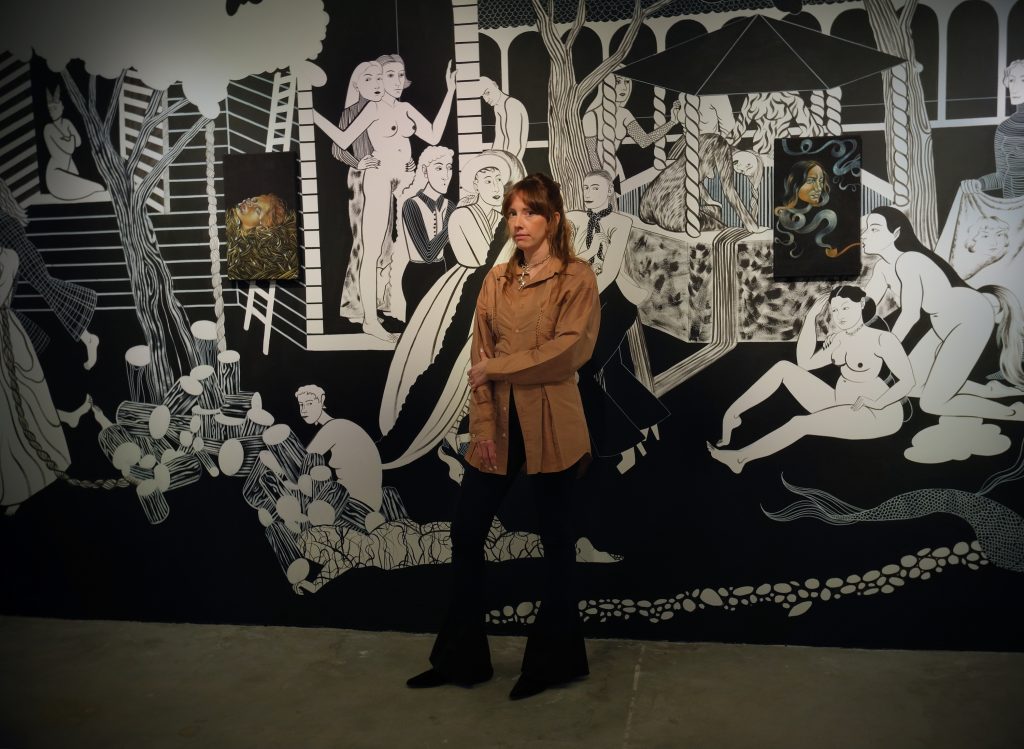
The sought-after British artist walked us through her new solo exhibition 'Bad sleeper' at New York's Lyles & King.

Katie White

“I had this vision of someone crying themselves to sleep in the hay,” artist Jessie Makinson said, standing beside her painting Hey Hay (2023). The painting shows a woman’s head, with no discernible body, lying atop a bed of straw. The woman looks out at the viewer, eyes alert, with an otherworldly, all-knowing calm, her golden hair mingling with the dried grass beneath her. Tears, like jewel-like guppies, wriggle down her inscrutable face and disperse through the hay below. “There are a lot of loose heads around here,” Makinson said with a smile, turning to face the rest of the gallery.
“Bad sleeper,” the London-based artist’s new solo show with New York’s Lyles & King and her third solo exhibition with the gallery, was on its final day of installation. Casting a glance around the downtown gallery’s three rooms, Makinson’s comment rings true: women’s heads, freed of their bodies, bob up here and there throughout these compositions. In one petite canvas, The Smell wishes, a woman’s face and her long dark hair seem to form from the smoke curling out of a pipe, with a Magritte-like effect.
For those who have followed the artist’s work closely, her newest exhibition offers an exciting new chapter in her oeuvre (in addition to with Lyles & King, she’s had critically acclaimed shows with Francois Ghebaly, in Los Angeles, and Galería OMR in Mexico City). In “Bad sleeper” for the first time, she has brought her painted world into three dimensions with interventions in the gallery space. A hand-painted mural in black-and-white fills an entire room; a carpeted gallery room has chapel-like solemnity, whereas the hard floors and archways of the rest of the gallery give the cool majesty of an abbey. What feels most undeniable is that Makinson has drawn us into a ritualistic, out-of-the-ordinary space, one that feels somewhere between reality and dreams, past and future.
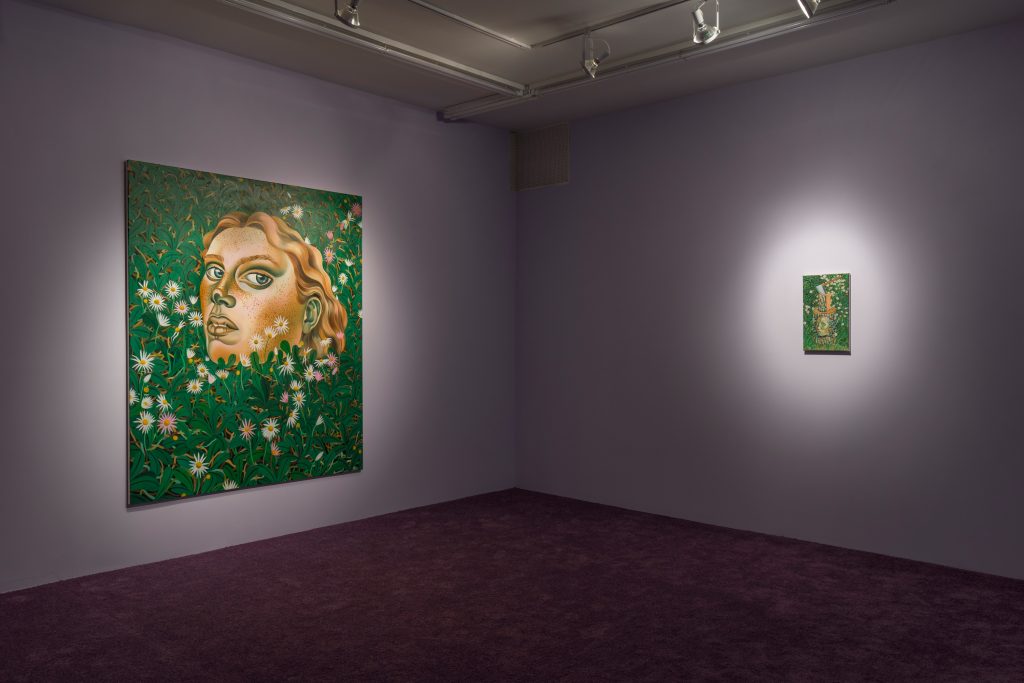
Installation view of “Bad sleeper” with Jessie Makinson’s Dig Her Up Dig Her Out (2023) on the left. Courtesy of the Artist and Lyles & King, New York. Photo credit: Charles Benton.
In another room, Dig Her Up Dig Her Out, a woman’s head rests upright on a grassy knoll, blades of grass, and little white daisies framing her freckled mien. Beautiful as they are strange, Makinson’s compositions have a wit and precision that is unmistakable. Her figures appear almost medieval in their nonchalance—these loose heads have nothing of the bursting drama of scenes of Biblical beheadings or slain Medusas. The women boast the calm of saints unaffected by their woundings.
“It’s more psychedelic,” noted Makinson, referencing the colors and patterns she’s currently engaging with. Certainly, this psychedelic turn could be said of her subject matter. Makinson is known for synthesizing a dizzying range of inspirations, often literary, before beginning a new series of works. Here, Polish author Olga Tokarczuk’s recent epic historical novel The Books of Jacob offered creative fuel for “Bad sleeper.” Tokarczuk’s book, which traces a Jewish family as it navigates assimilation over generations and centuries, is filled with wild folkloric imagery that pushes the boundaries of language and narrative layering to its limit.
“In the book, someone will walk through a field and feathers will get stuck to their leg or they’ll look on the floor and something’s written in daisies,” Makinson elaborated, “Every detail is an opportunity to add layers and layers to the story. That’s similar to how I work when I’m painting.”
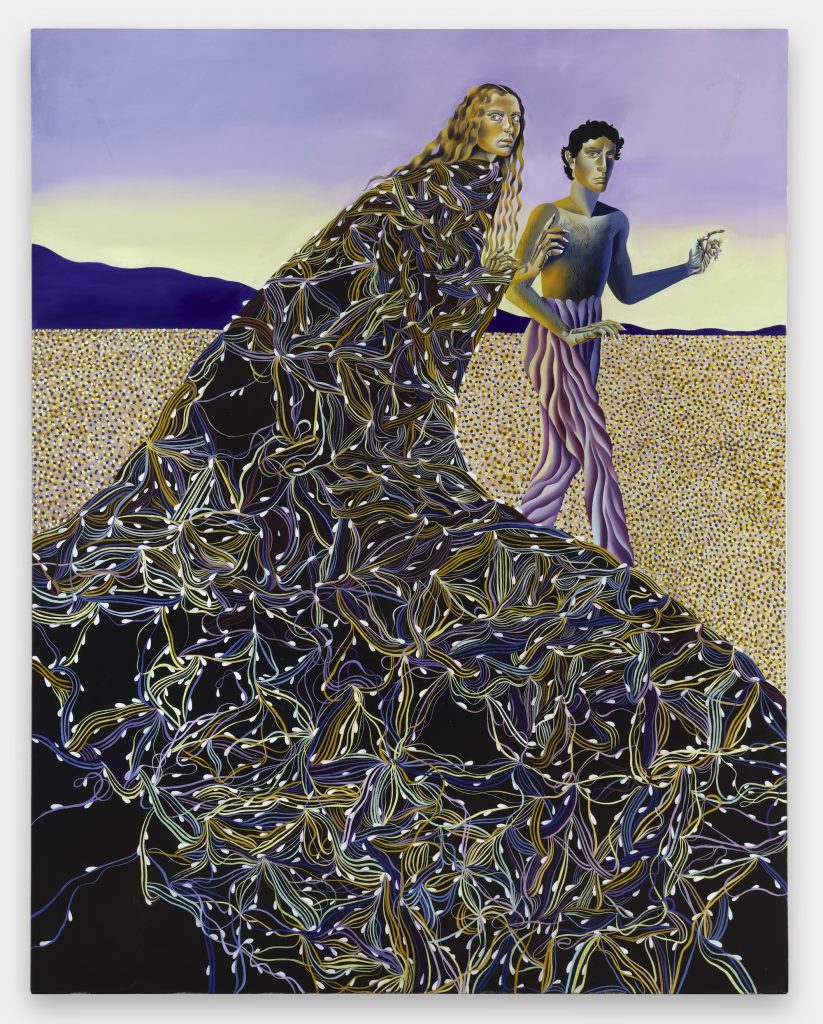
Jessie Makinson, Beprickled (2023). Courtesy of the artist and Lyles & King. Photo credit: Eva Herzog
Science fiction, too, remains a longstanding influence. Makinson considers her works to be “speculative fictions,” where androgynous and female protagonists appear as hybrids, both human and other—animal, plant, mineral. They are often clustered in crowded figural compositions, their bodies half-naked or veiled only into slips of patterns. Adding to this ambiguity, these characters’ nails are always talon-like. Makinson uses models for her figure’s faces, but the hands are all based on her own, and decidedly “witchy.”
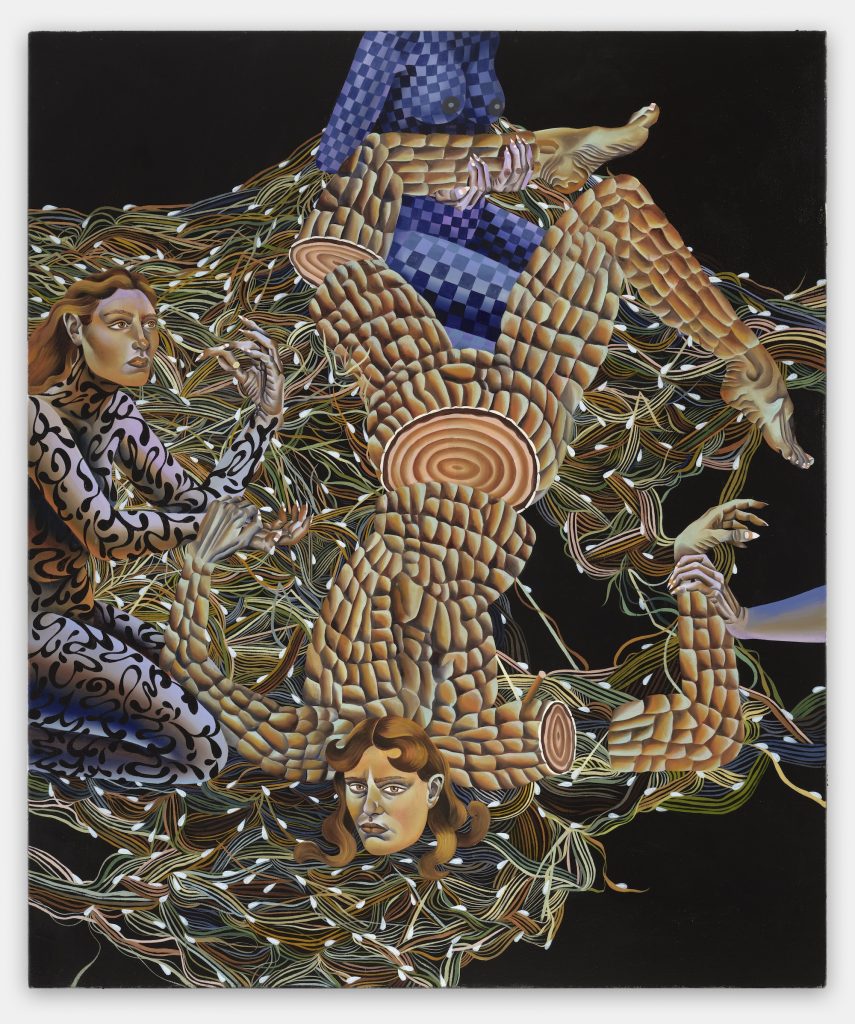
Jessie Makinson, Knowing your fingers (2023). Courtesy of the artist and Lyles & King. Photo credit: Eva Herzog.
These tableaux vacillate between intimacy and disengagement. In The Kings Limpet, a woman lies on a bed, her body covered in grass. Attendants surround her, with varied levels of interest. One figure runs a feather duster over the grassy woman, distractedly, in a gesture of caretaking that becomes a kind of afterthought. These figures’ discrete interactions and expressions can call to mind Renaissance tableaux—bringing to mind folkloric depictions of the Last Supper or altarpieces where the angels and saints have morphed with the visions of Hieronymus Bosch.
“The Kings Limpet is a bit based on Medieval Tudor bedding rituals when everyone comes to witness the bedding,” she explained, “But it’s all a bit off. One woman is being carried, her figure is slit in half. One woman carries her own head, another weird element, that’s my joke about the figure not fitting in the composition. Then there are all these other figures fussing about. Is it care or are they annoying one another? There is an unease that’s slightly out of frame.”
Surfaces are a perpetual fascination for her, and she describes her process as one of “wandering across the canvas, up close” her eye fixed on the rhythms between colors and patterns she adorns onto her figures’ bodies. On these surfaces, she pushes and pulls between volume and flatness, interiority and exteriority, color harmony and utter discord. For Makinson, these figurative compositions are a visual riddle, a puzzle. “I’m interested in veiling,” she said, “The clothes for my figures are never really kind of practical or functional, but explorations.”
Makinson’s visual elements often interact with one another in a manner that is locked together in a tightly annotated rhythm. Beprickled—one of the final works she painted for the exhibition—presents two figures, a man and woman, walking across a field of small circles, a mountain in the distance. The woman’s cape, dark and voluminous, spills out, covered in an undulating pattern of straw-like marks. The painting was inspired, in part, by Aubrey Beardsley’s famed 1893 illustration The Peacock Skirt. The work hints at what’s to come. “This is a new direction for me,” Makinson confessed. “I make heavily detailed paintings, but here I’ve broken it open and allowed for some abstraction.”
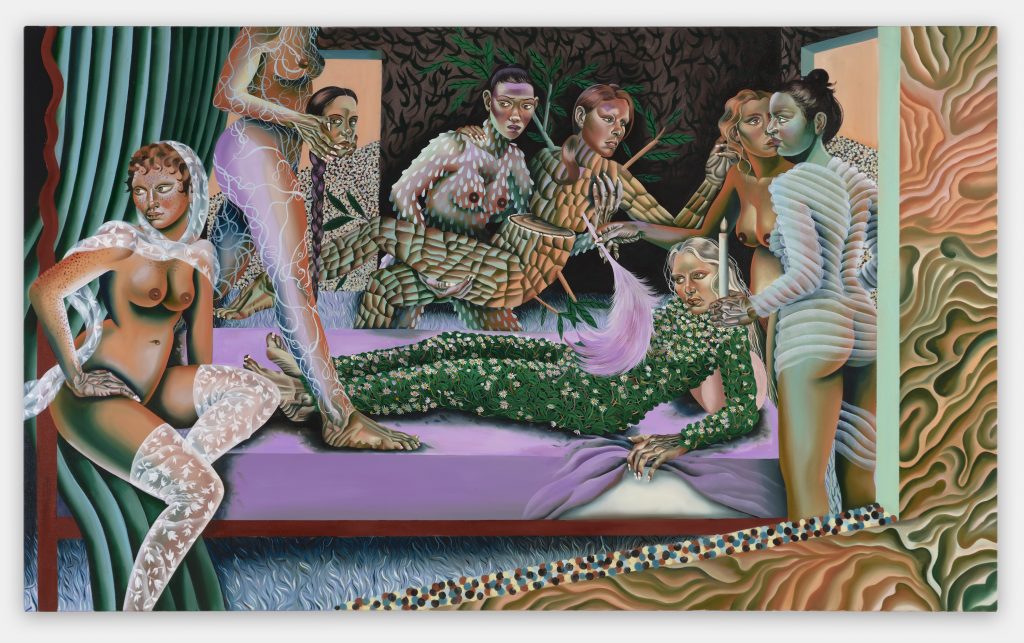
Jessie Makinson, The King’s Limpet (2023). Courtesy of the artist and Lyles & King. Photo credit: Eva Herzog.
More Trending Stories:
Conservators Find a ‘Monstrous Figure’ Hidden in an 18th-Century Joshua Reynolds Painting
A First-Class Dinner Menu Salvaged From the Titanic Makes Waves at Auction
The Louvre Seeks Donations to Stop an American Museum From Acquiring a French Masterpiece
Meet the Woman Behind ‘Weird Medieval Guys,’ the Internet Hit Mining Odd Art From the Middle Ages
A Golden Rothko Shines at Christie’s as Passion for Abstract Expressionism Endures
Agnes Martin Is the Quiet Star of the New York Sales. Here’s Why $18.7 Million Is Still a Bargain
Mega Collector Joseph Lau Shoots Down Rumors That His Wife Lost Him Billions in Bad Investments